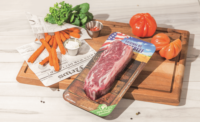In 1937, Marguerite and Michel Metzger opened their butcher shop in the village of Ittenheim, close to Strasbourg, in the northeast of France. When the first supermarket opened in Strasbourg in 1959, Metzger was chosen to supply the delicacies. In 1964, Roger Muller joined the company to create Metzger Muller Inc. Twenty years later, the company was the first in the region to pack meat for self-service. Today, Metzger Muller (www.metzger-muller.com) has an ultra-modern facility employing 64 people for processing its premium meat products.
Modernization
In 2009, Metzger Muller decided to modernize its processing facility, and over a period of approximately two years, the company had regular meetings with SEALPAC to discuss possibilities, in terms of machinery and packaging solutions. Numerous pack samples were developed to demonstrate actual appearance, seal integrity and easy opening.
Then, in 2011, Metzger Muller invested in several SEALPAC A6 traysealers and a SEALPAC RE25 thermoformer, offering a large variety of packaging solutions.
With its meat mainly coming from the Alsace area, Metzger Muller has a strong focus on regional specialties, such as palette à la diable. Consisting of pork meat in a delicious Alsatian mustard sauce, this product posed an interesting challenge, as highest seal integrity had to be achieved.
“When we started talking about new equipment, we considered stopping the production of our palette à la diable, as we saw no real chance of transferring this to a self-service concept,” CEO Daniel Muller explains. “That is, until SEALPAC explained the option of shrink packaging on a fully automated thermoformer. With several test runs, they showed us that highest seal integrity was achieved while giving this product an optimal presentation. We then started thinking about other products, and are currently running ring sausages and smoked meat pieces on the SEALPAC RE25 thermoformer.”
Like a second skin
Metzger Muller uses skin packaging for its sliced meat. After the meat is sliced, it is loaded into trays and transported toward the SEALPAC A6 traysealer. There, a high-transparent barrier skin film is sealed to the tray to fit the contours of the product like a second skin. “Skin packaging had been known within our company for over 20 years, but SEALPAC’s TraySkin® system with the possibility of product protrusion really surprised us in a positive way,” says Muller. “We obviously wanted to have no wrinkles in the skin film after sealing, the relatively low tray should not deform in the process, and we wanted to significantly increase the output of trays per minute. SEALPAC made that happen with its A6 traysealer.”
For more information, visit www.freshfoodpackaging.com.







Report Abusive Comment